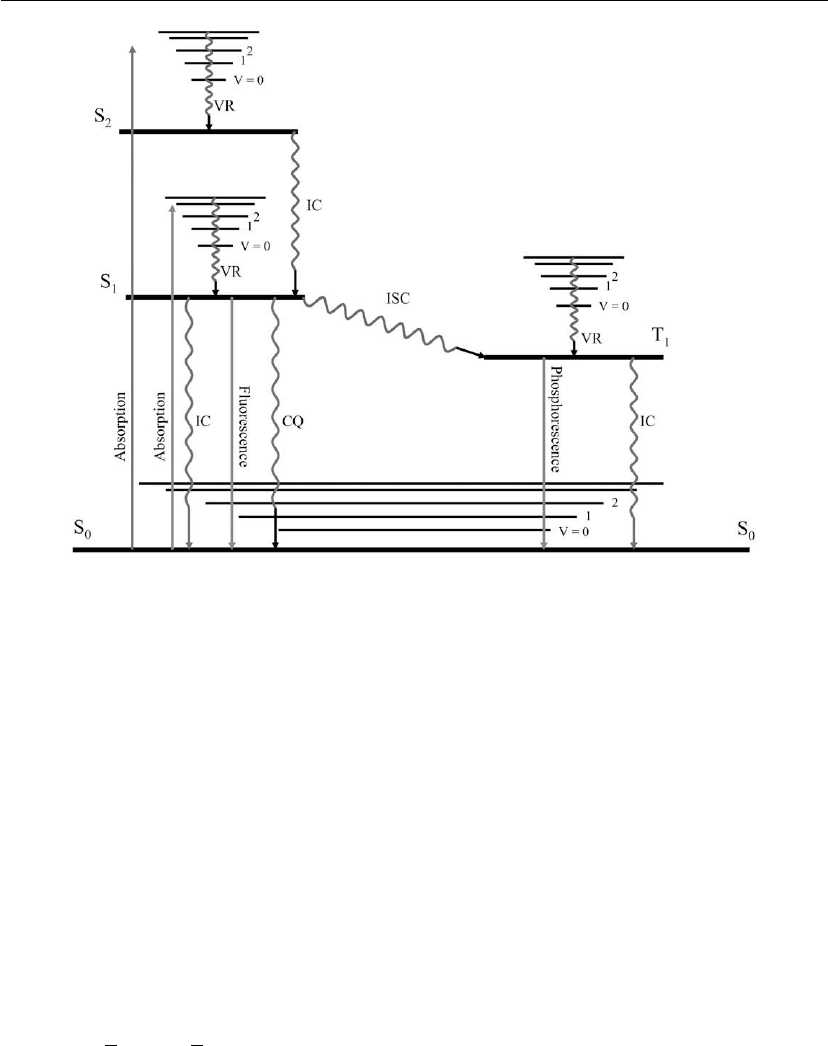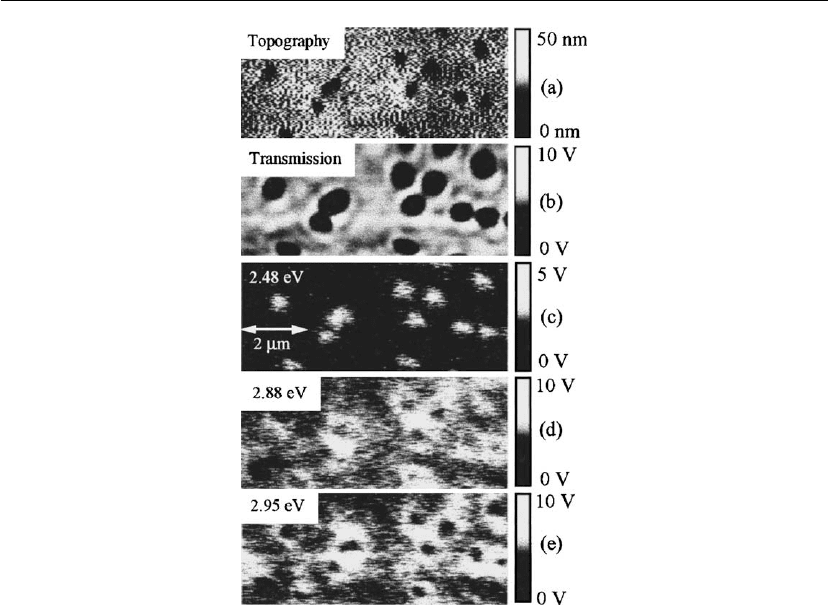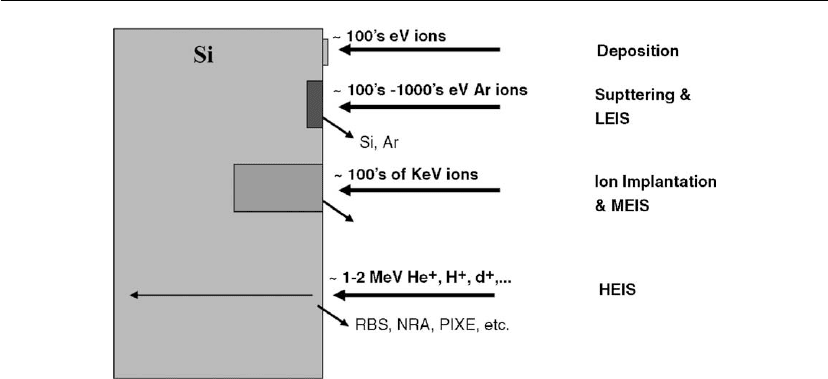Martin P.M. Handbook of Deposition Technologies for Films and Coatings, Third Edition: Science, Applications and Technology
Подождите немного. Документ загружается.


Characterization of Thin Films and Coatings 781
Figure 16.19: Jablonski diagram showing principles of photoluminescence spectroscopy.
Absorption of a photon excites an electron to an excited state from which it decays by a variety of
processes to lower energy states. Observation of the photons emitted provides fundamental
information about the energy levels in the system. See text for more details [57].
For molecular materials, the intensity and profile of the photoluminescence spectra are direct
measures of various important material properties such as the relative energies of the ground
and excited states, electronic transitions and concentrations of the emitting species [58]. The
temporal dependence of the photoluminescence reflects the relaxation characteristics of the
excited state, molecular bonding environment, and identification and quantification of
photoluminescence quenchers. The polarization change of photoluminescence reveals the
electronic transitions involved and the direction of the transition moments. For
lanthanides-based materials and some transition metals, the symmetry is related to band
splitting pattern and for lanthanides, such as Eu(III) and Tb(III), the quenching behavior offers
clues about the vibrational characteristic of its immediate surroundings, such as high-energy
vibrators, O
H and N
H [59, 60]. Fluorescence energy transfer studies allow identification of
other fluorophores in the vicinity of a molecule as well as the distance between them and the
nature of their association.

782 Chapter 16
For semiconductor materials, photoluminescence occurs in a similar mechanism.
Photoexcitation of a semiconductor material promotes an electron from the valence band to the
conduction band, leaving a ‘hole’ in the valence band. The excited electron in the conduction
band relaxes quickly, typically within 15–25 ps [61], to the band edge via inter- or
intra-sub-band scattering and then recombines with the hole either radiatively by emitting a
photon or non-radiatively by passing the energy on to one or more phonons, to ‘trapping’
states that are created by impurities, dopants, or defects and lie in between the conduction
band and the valence band (Shockley–Read–Hall recombination), or to another electron or
hole (Auger recombination). For radiative recombination, the emitted photon usually has an
energy equal to the band gap energy, hν = E
g
, where h is Planck’s constant, ν is the frequency
of the emitted photon, and E
g
is the bandgap energy. Therefore, photoluminescence spectra
and decay behavior (or lifetime) provide direct measurement of the bandgap energy, which
help identify and quantify the elemental composition of compound semiconductors, and
determine the presence of impurities, dopant concentrations, and structural defects, and
understand the electron–hole recombination mechanisms and evaluation and quality control of
semiconductor materials.
16.3.5.2 Instrumentation
The complexity of photoluminescence instrumentation largely depends on the parameters of
interests. Conventional photoluminescence (more commonly termed fluorescence)
spectrometers typically use xenon lamps as the excitation source. Most xenon lamps are
effective in a broad wavelength range from the UV to near-IR region. The excitation beam is
dispersed through scanning monochromators for sample excitation at different wavelength
(energies). The emitted fluorescence is collected at either a right angle (90
◦
relative to the
excitation beam) or front face (∼30
◦
) and dispersed through a second scanning
monochromator and then detected by a photomultiplier tube. Multiple slit mechanisms are
employed at both the excitation and emission sides to increase the monochromaticity of the
excitation beam as well as the photoluminescence emission. Photoluminescence lifetime
measurements are achieved by replacing the continuous wave xenon lamp with flash xenon or
xenon–mercury lamps or pulsed lasers and recording the photoluminescence intensity change
as a function of time after the pulsed excitation.
The availability of lasers and CCD detectors in the last couple of decades has significantly
improved the photoluminescence technique [62]. Lasers provide high-power, coherent
monochromatic light, greatly improving the spectral resolution and detection limit. Pulsed
lasers with pulse width at nanoseconds to femtoseconds not only permit photoluminescence
measurements with lifetimes in a broad range from milliseconds to subpicoseconds, and cover
most photoluminescence materials, but also facilitate a new suite of photoluminescence
measurements, called time-resolved photoluminescence spectroscopy [63]. Photoluminescence

Characterization of Thin Films and Coatings 783
spectra recorded at different delay times after the laser pulse allow temporal resolution of the
emitted fluorescence spectra and thus help with the identification of materials with
photoluminescence centers in different chemical environments and the elucidation of the
recombination mechanisms. The use of CCD detectors eliminates the scanning process of the
emission monochromator and thus significantly improves the throughput of the measurements.
This is particularly useful when using pulsed laser excitation sources. For these, the entire
photoluminescence measurements can be recorded with a single laser pulse, thus avoiding
measurement errors introduced by the instability and fluctuation of the excitation sources.
16.3.5.3 Photoluminescence Applications in Thin Film Materials and Future Directions
Because of its high sensitivity, providing rich information about the band structure,
electron-hole recombination and relaxation processes, and relative ease of use,
photoluminescence spectroscopy applies to the characterization, photophysical,
photochemical, and mechanistic studies of a wide array of thin film materials including
ZnO/II–VI semiconductors [64], III–V semiconductors [65], lanthanide-based optoelectronic
materials [66, 67], inorganic and organic light-emitting diodes (LEDs and OLEDs) [68], thin
film photovoltaic materials [69], and radiation detection devices [70]. Interested readers are
referred to many of the previous review articles and book chapters cited here [63, 71, 72].
Zinc oxide is a wide-band (3.37 eV, 60 meV exciton binding energy) semiconductor with
potential applications in photoelectronics, light-emitting devices, gas sensors, and solar cells.
Studies have shown that many properties of ZnO films are strongly dependent on the crystal
structure and orientation of ZnO, its crystalline quality and defect states, and thus vary as a
function of film preparation method, selection of substrate, and growth conditions. As an
example, for ZnO thick films (∼200 nm thickness) deposited on indium tin oxide (ITO glass)
by radio-frequency (RF) magnetron sputtering at a substrate temperature of 400
◦
C, the UV
photoluminescence of the film initially increases as the oxygen partial pressure (PO
2
)
increases from 0% to 60%, but then decreases as PO
2
increases further (Figure 16.20) [73].
The initial increase probably resulted from the improved stoichiometry of the films, associated
with the incorporation of oxygen at oxygen vacancies, while excessive PO
2
may worsen the
stoichiometry of the films by introducing interstitial oxygen or zinc vacancies. Gaussian fitting
of the UV-photoluminescence band gives three peaks situated at 380, 395, and 410 nm,
corresponding to recombination of free excitons through an exciton–exciton collision process,
emission from the ITO layer and O dangling bonds on the ITO surface layer of the interface
between substrate and ITO, respectively. The relative intensity of the 410 nm peak increases
with the excitation intensity.
The versatility of fluorescence detection also makes it possible to integrate photoluminescence
instruments with other experimental techniques such as optical microscopes and scanning

784 Chapter 16
Figure 16.20: Photoluminescence (PL) spectra of ZnO thin films on ITO glass with increasing
P(O
2
) [73].
atomic force microscopes. In addition, the non-contact nature of the techniques allows the
sample to be measured at different temperatures. The current trend in the application of
photoluminescence for thin film studies is closely coupled with technical developments in laser
fluorescence spectroscopy and scanning probe microscopy. Examples of such developments
are near-field scanning optical microscopy (NSOM) and non-linear optical spectroscopy.
NSOM is based on designs that limit the photoexcitation volume using a tapered, metal-coated
optical fiber, or field-enhanced excitation by noble metal probes [74]. Using NSOM, spatial
resolution much less than the diffraction limit can be achieved. Combining NSOM with
photoluminescence spectroscopy allows study of the photoluminescence properties of thin
film material with ultrahigh spatial resolution. Using this method, Crowell et al. [75] were able
to image photoluminescence in an InGaN/GaN quantum well with a spatial resolution of
approximately 100 nm for temperatures between 50 and 295 K, and directly correlated the
spatial features of the thin film material with photoluminescence characteristics (Figure 16.21).
Time-resolved photoluminescence (TRPL) measures photoluminescence intensity as a
function of time. With commercial high-speed detection devices such as time-correlated
single-photon counting and streak camera with femtosecond lasers as excitation sources,
luminescence measurement reaches a resolution of a few picoseconds. A new type of TRPL
technique that is based on sum frequency generation (or frequency up-conversion) has been
demonstrated [76]. This technique offers a time resolution on the order of the laser pulse
width, as short as tens of femtoseconds. Rain
´
oetal.[77] used this technique to measure the
rise and decay dynamics of the ground and first excited states of InAs quantum dots (QDs)
capped with an InGaAs quantum well and found that the higher energy states of the QDs do

Characterization of Thin Films and Coatings 785
Figure 16.21: Images of a 2.5 ×8 m region of the sample at T = 295 K obtained using the
near-field technique: (a) topographic image of the InGaN/GaN sample measured using the
shear-force feedback technique; (b) transmission image at the excitation energy of 3.16 eV; (c–e)
photoluminescence images obtained at detection energies of 2.48, 2.88, and 2.95 eV, respectively.
The grayscale for each image is indicated at the right [75].
not act as intermediate stages in the carrier relaxation, while the carriers can cool down to any
lower energy states following relaxation through a continuum background.
Strengths:
Non-contact, non-invasive/non-destructive.
Requires minimum sample preparation.
Sensitive to impurities and defects (low detection limits).
Applies to broad temperature range.
Ease of integration with other techniques.

786 Chapter 16
Offers direct observation of the electronic transition energies, including bandgap
energy.
The energetics and dynamics provide ideal tools in the study of recombination
mechanisms.
Limitations:
Only applies to materials that fluoresce.
Only detects electronic states that relax radiatively.
In some cases, unknown quenching mechanisms prevent quantitative measurement.
16.4 Incident Ion Methods
Ion beams are used in a variety of ways to characterize films and surfaces. Most of the
techniques involve either analyzing ions scattered from a sample to extract information about
the sample or using incident ions to remove material from the sample. Both methods are
included in this section. The several techniques involving elastic and inelastic scattering have
several common physical aspects and they are described as a unit, including: (1) low-energy
ion scattering (LEIS); (2) medium-energy ion scattering (MEIS); and (3) high-energy ion
scattering (HEIS) methods such as Rutherford backscattering spectrometry (RBS), nuclear
reaction analysis (NRA), ion channeling, and elastic recoil detection analysis (ERDA). Other
sputtering methods, such as sputter depth profiling, secondary ion mass spectrometry (SIMS),
glow discharge mass spectrometry (GDMS) and some applications of focused ion beams
(FIBs) use energetic ion beams. In addition, FIBs are often combined with electron
microscopy as the ion beam can be useful in the collection of high-resolution images. The final
section is on sputter depth profiling, which is useful for determining depth distributions and
layer thickness. This final section also includes a table comparing a variety of approaches for
determining film or layer thickness.
16.4.1 Ion Scattering Methods (LEIS, MEIS, HEIS, RBS, NRA, ERDA, Channeling)
V. Shutthanandan and Y. Zhang
Ion beams have been effectively used in material modification and material analysis for more
than 40 years. Ions at different energies are used to alter surfaces (or films) or to collect
different types of information about them. The picture in Figure 16.22 shows different
capabilities associated with various ion energy ranges. A few hundred eV to a few keV inert
gas ions, in particular argon ions, are extensively used in sputter cleaning of surfaces which are
necessary for surface science studies. In addition, a few keV inert gas ions along with alkali
ions are very useful in determining the structural and chemical properties of surface layers and
adsorbate layers. This capability is called LEIS spectroscopy, which is very surface sensitive

Characterization of Thin Films and Coatings 787
Figure 16.22: Schematic illustration of the uses of ion beams with various energies on Si substrate.
and it is described in detail in the following sections. MEIS spectrometry is a powerful
capability to characterize thin films of a few nanometers thickness. In general, about 100 keV
helium or hydrogen ions are used as an incident ion beam and electrostatic analyzers are used
to characterize the backscattered ions at large scattering angles. High-energy ion beams are
generally used for material characterization of both thin and thick films. Although several
high-energy ion beam-based techniques are available for material characterization, RBS,
NRA, proton-induced X-ray emission (PIXE), and ERDA are commonly used.
Although not the focus here, ion beams are also important for material deposition and
substrate modification. Ions with energies between a few eV and a few tens of eV enable the
‘soft’ landing of larger molecules on the surfaces and the deposition of thin films using ion
beam-assisted deposition. Material properties can be modified using ion implantation and it
has been a very valuable tool in the semiconductor industry. The research community is
investigating this capability for other applications including spintronics and photocatalysis.
Ion implantation is often carried out using ion beams with energies in the range of a few tens
of keV to a few hundreds of keV.
In general, the ion scattering spectroscopies are mass sensitive and mass selected information
can be obtained from the data. As a result, backscattering and forward scattering capabilities
along with nuclear reaction analysis capabilities are isotope specific. The experimental data
can be simply simulated using classical mechanics principles as discussed in the following
sections. The following elements are important to understanding and modeling ion scattering
from surfaces:
Energy transfer from a projectile to a target nucleus in an elastic two-body collision –
This concept is related to kinematic factor which depends on the mass of the

788 Chapter 16
projectile, target atoms, and the scattering angle. The energy of the outgoing ions is
related to the incoming ions through this factor.
Likelihood of occurrence of such a two-body collision – This factor is defined as the
scattering cross-section and the height of the experimental spectrum is determined by
the scattering factor.
Energy loss of a projectile moving through a dense medium – Since the ion beam loses
energy when it travels through the material, the stopping cross-section which is related
to the energy loss as a function of depth provides depth perception.
Statistical fluctuations in the energy loss of a projectile moving through a dense
medium – When the ion beams travel through the material, the energy spread will be
increasing owing to the interaction with the material as a function of depth. This
‘energy straggling’ needs to be taken into account in interpreting the experimental data
and determining various properties of the material.
Scattering kinematics
The simple solution to the equations associated with energy and momentum conservation
leads to the following equation (Figure 16.23):
K =
E
1
E
0
=
1
2
M
1
V
2
1
1
2
M
1
V
2
0
=
⎡
⎢
⎣
M
2
2
− M
2
1
sin
2
θ
1/2
+ M
1
cosθ
M
1
+ M
2
⎤
⎥
⎦
2
(16.4)
K is called the kinematic factor and it represents the ratio of the incident energy of the
projectile to the outgoing projectile energy. The masses of the projectile and target atom are
M
1
and M
2
, respectively, and the scattering angle is θ. The outgoing projectile energy,
E
1
= KE
o
, and by measuring the energy of the backscattered ions the composition of the
material can be determined as a function of depth. The variation of K as a function of the mass
Figure 16.23: A cartoon picture depicting the elastic collision between the projectile with mass M
1
and target atom with mass M
2
.

Characterization of Thin Films and Coatings 789
of the target atoms for light projectiles such as hydrogen and helium ions indicates that the
differences in K for light target atoms are larger in comparison to the heavy target atoms. As
such, for the helium ions which are commonly used for RBS, light target atoms can be easily
separated while the separation between heavy target atoms is relatively difficult, in particular
when the elements are close to each other. Heavy target atoms can be separated using heavy
projectiles, but these may damage the sample.
Scattering cross-section
The scattering cross-section, σ, is defined by the following equation:
σ(θ) =
Z
1
Z
2
e
2
4E
2
4
[1 − ((M
1
/M
2
)sinθ)
2
]
1
2
+ cosθ
2
sin
4
θ
4
[1 − ((M
1
/M
2
)sinθ)
2
]
1
2
K =
E
1
E
0
=
1
2
M
1
V
2
1
1
2
M
1
V
2
0
=
⎡
⎢
⎣
M
2
2
− M
2
1
sin
2
θ
1/2
+ M
1
cosθ
M
1
+ M
2
⎤
⎥
⎦
2
(16.5)
where Z
1
and Z
2
are the atomic number of the projectile and target atom, respectively, and E is
the energy of the projectile. This equation clearly demonstrates that the energy and atomic
number of the target atom depend on the scattering factor as follows:
σ(θ) ∼ Z
2
2
σ(θ) ∼ E
−2
Since the scattering cross-section relates to the signal amplitude of the backscattering
spectrum, the backscattering signal would vary as a square of the atomic number of the target
elements. As such, the backscattering signals from the material that consists of heavy elements
will provide larger signals. On the other hand, the signals from the light elements are weak and
the detection and quantification of light elements in a heavy element matrix will be difficult.
As such, thin films that contain heavy elements on light element substrates can be successfully
characterized using backscattering spectrometry. The energy dependence of the scattering
cross-section exhibits the 1/E
2
relationship and for E > {1/2} MeV the scattering cross-section
does not vary significantly as a function of energy. Less variation in scattering cross-section at
higher energies makes the thin film analysis easier and 2 MeV helium ions are generally used
for RBS.
Energy loss and energy straggling
When the energetic ions travel through the material they lose energy owing to nuclear and
electronic interactions with the target atoms. In general, since the radius of the nucleus is
small, nuclear stopping is small in comparison to the electronic stopping. Excitation and

790 Chapter 16
ionization during the inelastic collisions with the electrons in target atoms contribute to the
electronic stopping.
The rate of energy loss is defined as dE/dx, the change in energy (dE) per unit distance (dx) the
ion beams travel inside the material. The stopping cross-section (ε) is defined as the ratio
between the rate of energy loss and the areal density of target atoms within the distance
((1/N)(dE/dX) −N is the areal density of the atoms within the distance dx). Since the stopping
cross-sections have been already established for many materials as a function of energy, the
thickness of the materials can be determined.
Although energy spread (energy straggling) as a function of depth is important for bulk
materials, for thin film measurements this can usually be neglected. As such, energy straggling
is not discussed in detail in this chapter.
As discussed in the above sections, the analysis of ion scattering data is straightforward
because the kinetics of energetic ion–atom collisions and scattering can be accurately
described by simple classical mechanics concepts. During the collision, the ions lose some of
their energies to target atoms. The backscattered ions have energies equivalent to the product
of the incident energy and the kinematic factor while the target atoms recoil to the forward
direction owing to the energy gained. As such, the final energies of the scattered ions and
forward recoiled atoms can be determined in a particular direction using the mass of the
projectile ion and target atoms. LEIS, MEIS, and HEIS capabilities are briefly described in the
following sections.
16.4.1.1 Low-Energy Ion Scattering
Incident ions with energies ranging from 1 to 10 keV are used in LEIS investigations. Since the
ions have low energies, the ions penetrating beyond the first one or two layers are neutralized
and, as a result, not detected. As such, this capability is very surface sensitive. Some of the
ions which interact with the surface layer are also neutralized. In addition to the scattered ions,
the neutrals can be used to obtain information from surfaces. LEIS can be efficiently used to
characterize surface composition and surface structure [78–84]. Ion neutralization can be used
to probe the spatial distribution of surface electrons. Since the number of scattered ions is very
small compared to the incident ions (< 5%) neutralization was initially perceived as a feature
that complicates ion scattering analysis. Most of the conventional ion scattering systems were
not equipped with instrumentation able to capture the neutrals and it was difficult to separate
neutralization effects. To overcome the issues associated with neutralization, Niehus and
co-workers [85, 86] developed the use of alkali ions instead of conventionally used inert gas
ions. Alkali ions have low neutralization probabilities and, as a result, the scattered intensity of
the ion is significantly higher than that of inert gas ions. However, surface contamination by
alkali ions can be an issue. During the late 1980s and early 1990s time-of-flight (TOF)
methods including mass spectroscopy of recoiled ions (MSRI) and direct recoiling
spectroscopy (DRS) to analyze both scattered ions and recoiled neutrals were developed and
